A Practical Guide for Wearing Dresses
With Pictures From Real Women Who Know How to Be Beautiful While Getting Dirty
Note: I've already written here and here on why I believe it's important to wear dresses. This essay is for all the women who messaged afterwards requesting tips on how to wear a dress practically.
Thank you Sarah Barnett, Charity Brown and sisters, Faith Farmer, Agatha Fehr, Alya Gray, Katherine Hackney, Tiffany Hale, Christy Ireland, Tessa Lamb, Laura Luker, Grace Margrave, Erica Matthews, Julie Morris, Kabayah Pilgrim, and Linda Remillard for contributing photos!
We spent much of last month in NYC with my husband’s mother who is on hospice. Due to the nature of her condition, she is unable to wear pants. She is in a gown or a dress. These suit her well though — she looks good in a bright color, and the dress adds vibrancy for these final hours. She is well dressed, and because of that, quite human and alive despite the situation.
The city environment is overstimulating — but there was much opportunity for people watching and observing the clothes they wear.
I couldn’t tell if many of the people I saw were female or male, even when trying to examine their hips, necks, elbows, or hands — the hands are the last, true sign of gender. Their fashion — straight jeans and loose shirts — made them appear as if they were emulating a stylish (unisex) box.
Later, in a boba tea shop, I noticed three youth who were doing their best to be non-binary. I’m certain two of them were girls, and the third was a boy.
When it came time to go the boy said, “Here, let me carry everything out because I’m the. . . tall one.”
I expected him to say man. The instincts to be a gentleman were present, but his values forced him to reframe his request.
The girls of course refused, “No. Just because you’re tall doesn’t mean you’re stronger.”
Despite the influx of non-binary fashion, dress-wearing is trending. Many women don’t want to look like men anymore. This, too, was evident in NYC. While we were in urgent care, I noticed a few of the nurses did not wear scrubs but lovely light blue dresses.
In the heart of Manhattan I saw many women (and men) in long, elegant dresses. The desire for femininity to have a come back (aesthetically at least) is palpable.
We see both these extremes represented, too, in modern fiction.


Felicia "Snoop" from the Wire. I didn't realize she was a woman until several episodes in. She walks, speaks, talks, and acts like a man — except she actually shows less emotion than any other man in the show. She is one of the best fictional representations I've ever seen of the "sexless" human.
The pull between “erasing gender stereotypes” vs “secular liberals obsessing over traditional femininity” is stark in Severance. The show has all your token woke features: homosexuality, licentiousness, feminism, pansy men etc. But it also has home-birth, breastfeeding, and women predominately dressing like women. There’s also a noticeable absence of “I’m a woman, I can save the day, too!”
Instead the women (even the villainous women) are like flowers amidst men.
The Real Woman
What is a woman?
How Woke Women Are Doing a Better Job Than Christians at Being Women
Modern culture is turning.
It is obsessed with feminine women and masculine men just as much as it yearns to eradicate gender roles. Right now this obsession seems to be mostly aesthetics, although I’m seeing many on the left express an urgent desire to learn the values that accompany the fashion. I believe it’s only a matter of time before they find God, too. For now (for them) the beginning seems to be wearing more gender-coded clothes. Naturally this isn’t unique to the left. Many, many conservative are looking to dress in a way that is more flattering to the female form.
This is not a political, or even a religious issue. Women are tired of being and looking like men1. They are done with homogenized culture. They are tired of being second class men. Of course there is a difficulty in all this; many first-world women have forgotten how to wear a dress.
Although dress-wearing was the norm throughout all of western civilization for thousands of years, it took only a few generations to strip women of their practical and intuitive instincts to move, work, and live in a dress. A lot of what our ancestors might have safely done in a dress now seems impossible or downright inadvisable.
But wearing dresses doesn’t have to be like that. It can be the most liberating aspect of your day-to-day life. Aside from the initial process of learning to feel comfortable doing some thing different, wearing a dress should NEVER feel more burdensome or dangerous.
If you possess the right set of skills and knowledge and have a well-suited wardrobe with the correct cuts and materials and undergarments, anything is possible in a dress. As many older women have told me, “If you can’t do it in a dress, you probably shouldn’t be doing it.2”
Practical Tips For Everyday
I intend to make this list as exhaustive and comprehensive as possible. However, I will not be advising you on modesty, I will not be sharing any etiquette tips, and I will not be telling you how to dress historically accurate.
Only you can figure out how to dress modestly for your body type. There are many wonderful books out there on etiquette, which often have less to do with the clothes you wear and more with how you carry yourself in what you wear. As for historical accuracy — this is not a how-to for larping. I’m writing about real life and how you as a 21st century modern woman can be feminine in whatever dress you choose to wear.
The Basics:
Materials
Everything boils down to the fiber content. Generally, you want durable fabrics for chores and thinner fabrics for special occasions. You don’t want to wear a silk dress while rustling cattle — nor should you wear a canvas skirt to church. I prefer to wear all natural fibers. In the winter I wear a lot of wool and corduroy. In the summer I mostly wear linen, rayon3, hemp, and cotton.
Many of my clothes can be worn in both seasons if I layer them with a wool tank top, wool leggings, and wool cardigan. If I’m doing messy or difficult chores, I’ll wear denim or cotton canvas — I consider these two fabrics “work” fabrics and rarely wear them otherwise, especially denim. I have a love/ hate relationship with denim. I feel it’s worn too much, but it is great for those days where you need to work hard without worrying about ripping your clothes. I love cotton velvet for winter socials — it’s warm but luxurious.
Thigh Rubbing
Wearing dresses can be so freeing for the legs… until your thighs start rubbing. This is not an issue in the winter when you’re wanting extra layers anyways. However, it can pose a problem for humid summer months. You have a couple options.
1) Wear shorts under your dress
2) wear longer, thigh-length underwear
3) apply lotion, coconut oil, tallow, or cocoa butter
If you choose the last option, your thighs will eventually build a callous. But until then make sure to do it before you go on any major hikes, and pack a pair of shorts just in case it doesn’t work. Depending on how much I’m doing, I don’t usually need to do any of the three when I’m at home even though I have large thighs.
Wind
I lived in Montana for well over a decade. It is already known for its wind, but my family somehow ended up in a valley with record-breaking wind. For this reason a lone, many women there think it’s inadvisable to wear dresses. It never stopped my family though.
If you live in a windy place, simply wear thicker clothes — save the cotton gauze dresses for another day. You can also choose skirts or dress that fit your hips. Skirts that fit to the knees then flare out are great because they’ll stay down, but allow you to work on the farm.
However, if you must wear that lightweight dress with a full, gathered skirt, you can
1) p your hand on your thigh to prevent the dress blowing up
2) gather your skirt in your hands and hold around your knees as you walk
3) purchase skirt weights
4) wear leggings or bloomers underneath and let the wind do what it will
Rain
Rain gear for women can be flattering and adequate. You can purchase rain skirts to wear with a short jacket, or long rain coats that give you complete coverage.

Grass Stains
I don’t worry about preventing grass stains when I’m in work clothes, but it is something to consider if in a pretty dress at a picnic. If you don’t have a blanket or a jacket to sit on, you can wear bloomers or leggings, then lift your dress up behind you, sit yourself directly on the grass, and billow your dress around you so none of it is pressed into the grass.
Shoes
I don’t like the look of tennis shoes with dresses or skirts. My husband thinks it’s cute, though. Some of these things are preferential. However, I personally believe that dresses look best with bare feet. If you must wear shoes, go for leather boots or sandals. I like brown because it’s a neutral color that isn’t black (morose, bland) nor white (hard to keep clean). I mostly thrift my shoes, and purchase for shoes or heels that will match most of what I already own.
Snow/ Winter
I made myself a pair of wool snow pants that are so thick I can do just about any snow activity in them without getting soaked. I usually wear them under a wool skirt, although the snow pants are so warm I can wear a lightweight cotton skirt over the pants. The skirt might get wet, but my skin never does.

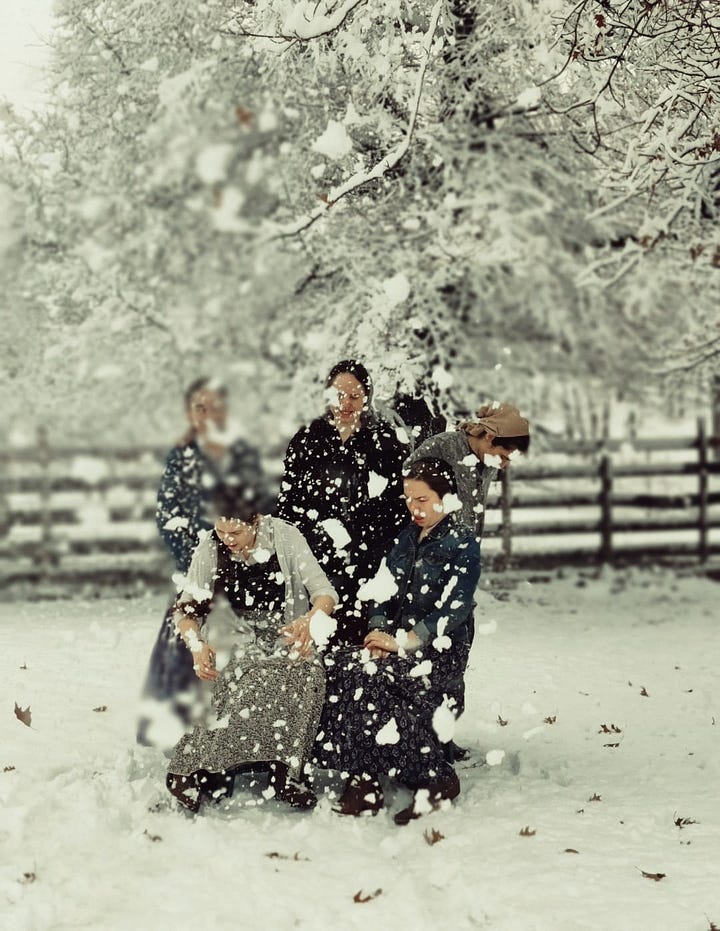
Typically I wear lightweight wool leggings or tights under wool or corduroy skirts or dresses in the winter. I often wear a wool tank-top under my dress or blouse. Sometimes that’s enough if I’m not doing snow-related activities. After that I add on layers of wool sweaters and cardigans — sometimes one, two, or three. I thrifted a down coat that fits well over three or four layers.
Staying Cool in the Summer
Despite what others may tell you, shorts4 are not cooler than dresses. It’s all about the material you choose. Linen, cotton, and rayon are breathable fabrics that permit ventilation. If you’re not wearing leggings and your dress is lightweight, you’ll feel great. If you do wear leggings, choose cotton. Even better: make yourself a pair of leggings out of a thin linen or cotton.
1) Avoid all polyester in the summer5. It will heat you up faster, cause you to sweat, and create unpleasant body odors
Grooming
The dress does most of the work. I remember back when my siblings and I were in youth group. Often we’d work long days then stop only right before we needed to leave, often not changing our clothes nor showering.
One day our youth pastor told me, “Your sisters and you are always so well dressed for youth group. It’s very sweet to see.” I laughed. All the other girls were clean and in fresh clothes. My skirt was torn from working, and had dirt and grass stains from the garden. But because my sisters and I were wearing skirts we automatically looked “better” dressed than the others.
That was all it took. We hardly even needed to brush our hair. Now, I’m not arguing that you should stop grooming yourself if you exclusively wear dresses. I mean only to point out that much is forgivable in a dress. There’s no need to paint your nails or wear make-up. You don’t even need to do much with your hair — simple styles better complement dresses. You don’t need to shave — most people won’t even notice the hair on your legs if you’re wearing dresses past the knees. If they do notice, and your dress looks nice, they’re less likely to assume you’re lazy but rather that you intentionally don’t shaving6.
Maintenance
I don’t wash my dresses until the underarms start to smell, or they have visible dirt. I’m not an apron-wearer, but you can preserve the life of your dresses by wearing aprons. When I do wash my dresses (linen, cotton, rayon), it’s usually after they’ve been worn at least half a dozen times. I wash them in cool water with light detergent and hang dry all my dresses and skirts, even the work ones. Turning them wrong side out will help prevent snagging and fading.
I usually wash my silk dresses after the first wear — I do them by hand and without soap. Wool rarely needs washed. When I do, it’s by hand, not agitated nor scrubbed, and without soap. If any of my nicer dresses acquire stains, I soak them immediately or as soon as I can. I usually don’t wash clothes that need mended as washing can cause fraying. I repair them first, then wash them.
1) Undergarments
“Why wear a dress at all if you’re going to wear leggings underneath anyway?”
There are two main reasons women historically took issue with pants. First, it was considered men’s clothing. The second reason, however, was that it was viewed as no different than going about in your underwear.
Indecent clothing aka “unmentionables” was not limited to lingerie in those days, but included slips, bloomers, nightgowns, etc. These garments didn’t need to be “immodest” or expose skin in order to be deemed improper. These garments were scandalous to wear on their own because they were the sole separation between a woman’s dress and her skin.
With this in mind, think about what it was exactly that women wore when they first started wearing “pants”. It was not men’s trousers, but their bloomers! Those early feminists decided they didn’t need their dresses anymore — their underthings were sufficient! If modesty had been the only objective, they were not wrong. Yet, many, many women were horrified because it was indecent that any woman strut about in her underclothes.
These days we’re less worried about the nuances between what is decent and what is immodest. Our goals are simpler: we want to be feminine. Like historical women, we also don’t want to needlessly expose our legs or catch cold. And so we wear both bloomers and dresses in order to be both sufficiently covered and beautiful7. We could wear less, but that’s not the point.
Slips
Slips serve three main functions. They keep your outer skirt or dress from clinging to your legs, they prevent light from shining through and highlighting the shape of your legs, and they add vitality to your outer dress or skirt while also enhancing the shape and size of your hips. The style of slip you choose depends largely on your desired results. Store-bought slips are often polyester. I like to make my slips out of thin undyed muslin or cotton.
Full a-line slips with no waistlines are great for thin dresses. They don’t add bulk around your hips or stomach area, but prevent the dress from clinging to your legs
Full slips with gathered waistlines are great for dresses that need an extra boost around the hip area. Even if you don’t need to enhance your hips, you may need this slip to add vitality and volume to a gathered dress that would otherwise fall flat
Half slips that hug the hips prevent clinginess and exposure from light
Half slips that are full add vitality to an otherwise lifeless skirt or dress. Alternatively you can wear another skirt under your skirt or dress as a slip. One of my friends always wears two skirts. The hem of her underskirt additionally serves as a sort of secret handkerchief
You can get fun with any of these by adding lace or ruffles to peep out from under the edge of your skirt or dress. If you’re wearing a full slip, you can also add detail around the neckline to raise a dress neckline. If you’re wearing a ball gown you’ll want a slip/ petticoat with many layers to add adequate volume to your dress.
Leggings/ Tights
I only buy cotton, wool, or hemp leggings and tights. I don’t really care for linen leggings because they’re often baggy and I feel that doesn’t look good under dresses.
Tights are great for fancier clothes with high-heels. They serve for warmth and aesthetic. Leggings are great for protecting your legs while working, keeping warm, preventing chaffing, and modesty.
Bloomers
Bloomers, unlike leggings, are loose, and often frilly. They are good for summer days for when you feel like you need extra coverage but don’t want to overheat. They are also pretty and look good under dresses. They are great for little children who want to play without worrying about their dresses flying up.
My mother made all the bloomers we wore growing as children out of thin cotton or muslin, and she’d edged them with a ruffle and lace.
2) On The Farm
Wearing a dress shouldn’t feel like a life-sentence as a wallflower. You can be beautiful and scrape your knees. You can be a woman with rough hands. You don’t have to choose between your femininity and the practical needs of everyday life.
I was a certified bookworm as a girl, and I especially loved historical fiction. But I couldn’t stand the trope where some girl schemed and contrived to steal a pair of her brother’s pants so she could do this daring, impossible feat like rowing a boat or riding a horse. It always ended with, “Oh, if only I could always wear pants how much better life would be!”
I simple couldn’t relate. It seemed forced. I, in this modern age, wasn’t handicapped by my dress, and I doubted that many real, normal historical girls were daydreaming about wearing pants, either. And they weren’t helpless for it. They were skilled and feminine and capable in a way these modern authors simply couldn’t fathom.
I’ve never once found a true need to wear pants. There is absolutely zero evidence that wearing pants is safer than wearing dresses. Anyone who tells you otherwise lacks skill and experience. If you know what you’re doing, and you’re comfortable in your clothes, the dress won’t make that much of a difference.
Tending a fire
I’ve heard many say that dresses are so dangerous women historically were more likely to die in them due to how “easy” it is for dresses to catch on fire. This is true only for a specific type of dress — a dress made entirely out of flammable substances and so large five women might fit inside it. Which would make it quite difficult for the one woman wearing to get out of it if she caught on fire.
There were women who burned in flammable dresses, but these were not common housewives. These were aristocratic women who had nothing better to do than wear frivolous garments of extraordinary size, shape, and material. And they died doing nothing of consequence.
Their fancy dresses would get too close to a cigar or a candle, or even a hot stove, and would ignite in a fraction of a second.


Normal working women who tended fires didn’t die as often. Of course, normal women were also wearing simple handspun linen or wool, which if caught on fire turns to ash and falls away from the skin instead of melting into it. The common women’s dresses were made practically — not too full or too tight, easy to get out of, easy to move about in.
Women who tend fires and regularly work and wear dresses will bunch their dresses up around their knees. If they are working in a blacksmith shop they are going to want a leather apron, not pants. Dresses will not hinder the skilled black smith, unless the dress is a crinoline ball gown.

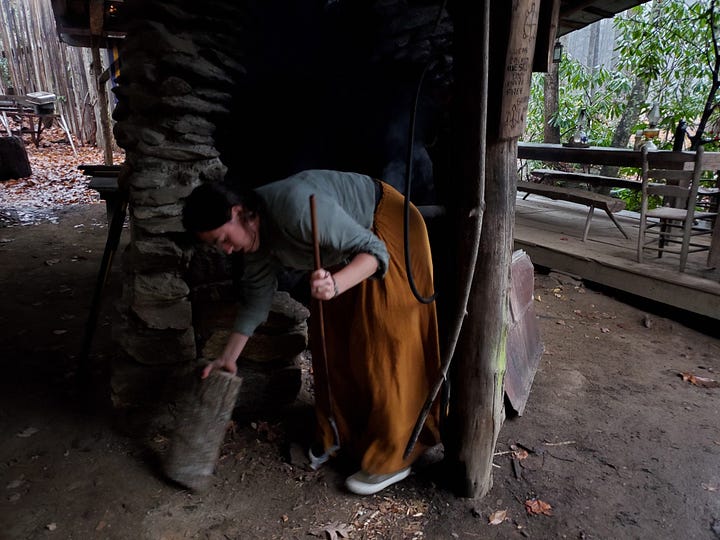
Tractors/ Machinery
One certainly wants to be careful around machinery no matter what they are wearing. It doesn’t take wearing a dress to die — a shirt sleeve or pony-tale could be all it takes. As soon as you take on machinery of any sort, you’ve signed a petition to die in a million ways. Nevertheless you can wear dresses in the field and on the tractor and in the factory and survive to tell the tale.
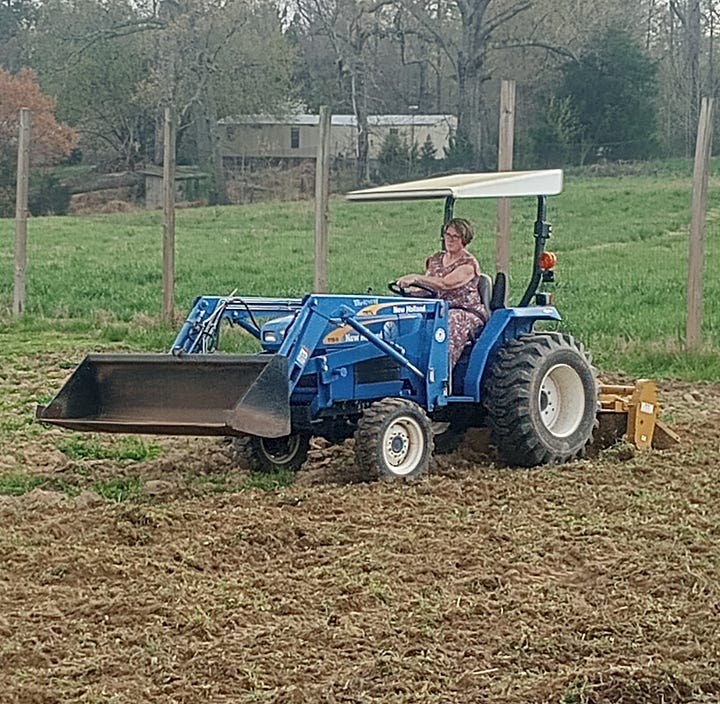
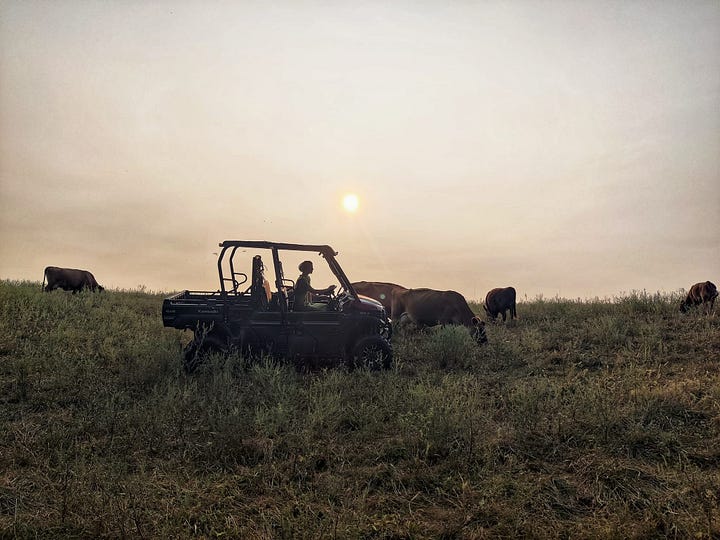


1) Choose durable fabrics such as denim or canvas. There are many girls who wear a cotton dress on a tractor, but those women have been raised in a skirt and are something of a fairy — it’s very hard to get to that level of skill if you’re just starting to wear dresses
2) Don't wear full dresses or skirts. Flared skirts (tight at the hips, loose below the knees) are best
3) If your dress catches, let it tear. It’s better to mend your garment than loose a limb
Ladders And Climbing Other Things
Climbing a ladder, crossing a fence, and climbing a tree can be done in any skirt of any fiber or weight if you’re doing these things for fun. If it’s for work, you’ll want to wear suitable fabrics.
1) In order to climb a ladder, you’ll simply grab the edge of your hem and hold it as you go up. If the skirt is very full you’ll grab more of the hem. Sometimes I put my hem in my teeth.
2) When crossing a fence you want to grab your skirt between your legs, pull it up toward your waist so as to create a harem pants look, and then cross. If it’s barbed wire make sure every bit of your skirt is pulled tight against you.
3) When climbing a tree you’ll do a mixture of the last two, depending on the shape of the branches and how high you’re going.
4) When climbing stairs, grab a bit of your skirt at knee level on one side and pull up as far as you need. If you have things in your arms, you can tuck your skirt hem under your elbow.
I sometimes tie my skirt up, or gather the excess and pull it through a hairband at my side. This method isn’t necessarily safe for tree climbing as it can easily come undone.
Livestock and Farm Chores
I used to have the meanest buck. I called him Gollum. Every morning I’d go out to give him fresh water and he’d charge me. I would have to move fast. I’d dodge his attack, grab his neck and wrap my arms around his horns, then knee him to the ground. We’d stay that way for many long minutes until I was red in the face and he was done struggling. Only when he was finished fighting would I let him go and he’d run off while I refilled his water.
Every morning he’d repeat this. I usually wore a full skirt — a cheap cotton gauze — and rarely wore leggings. If he’d won, I’d have more to worry about than scratches on my legs. My skirt never tore and I was never hurt.
I survived in my gauze skirt. Nevertheless, those were not ideal clothes for such a situation. I probably should’ve worn leggings and a denim or canvas skirt. But back then I really hated things on my legs and didn’t like the feel of heavier materials. I guess I thought it was worth the risk.

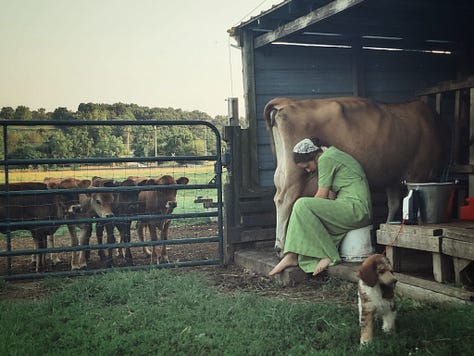

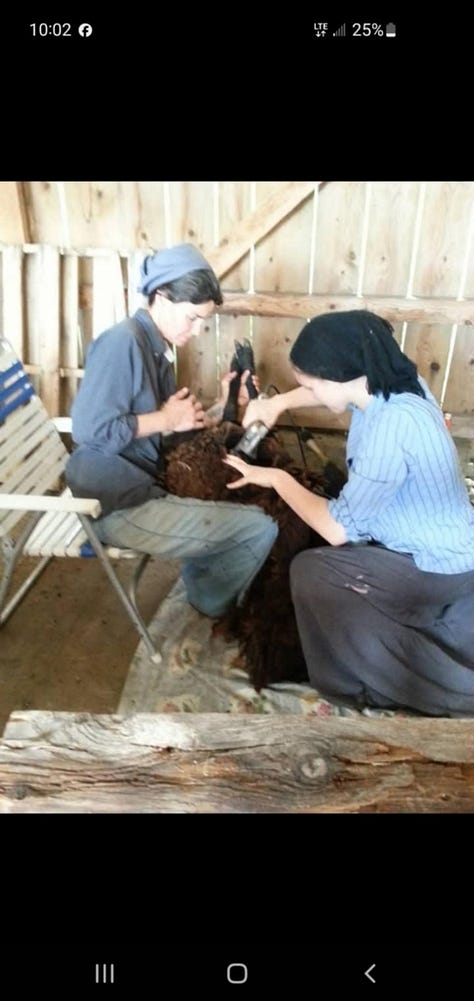


Most farm chores can be done in a simple cotton dress. Milking, rounding up sheep or goats or cows, butchering, sheering, feeding bottle babies, cleaning up debris, etc can all be done easily in a summer dress. You might want to choose a dress that you don’t mind getting stained, but these chores rarely require thicker fabrics. There are other chores that can be done in a cotton dress, but you risk tearing it more easily: fencing, roofing, construction.
I’ve had several ranchers message me pointing out that branding is impossible to do in a dress. However, women have been branding in a skirt or dress for generations8. Even this is possible, although you’ll still want to wear leg protection, not wear too full of a skirt, and wear some thing made of denim, canvas, or leather.
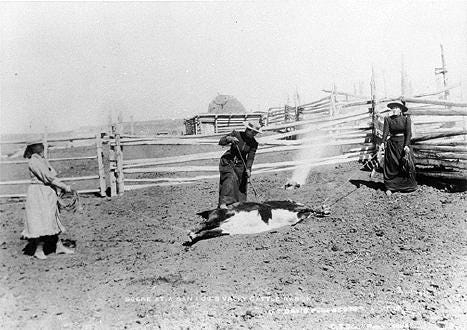
“Never did wear pants, and I haven’t yet! I leave that to the men. I did—I wouldn’t wear them. You know, my legs feel like they’re smothered. I’d be out there at our ranch, and in the wintertime [my husband] was always gone up to Mt. Harris to work, because we needed the money. I stayed home, took care of the cattle, horses, and everything. Pumped water for them and all. Well, after we had a few head of cattle, I had to hook up our team of horses and haul the straw out—we didn’t have hay; it was straw—and pump the water and slop the pigs and take the kids to school when they started. . . . “
Source: Julia Biskup Kawcak quoted in Julie Jones-Eddy, ed. Homesteading Women: An Oral History of Colorado, 1890-1950 (New York: Twayne, 1992): 64.
Women of the west were wild and exceptional, but very few of them were as brazen as Hollywood might have you believe. Most western women were not comfortable in men’s clothes, and considered such behavior disreputable.
Although Calamity Jane is painted as some sort of folklore hero, in her day women were ashamed of her sort. A woman could work hard without losing her femininity. Many women, although often glossed over in history books, did just that accomplishing all manner of feats proudly in their dresses.

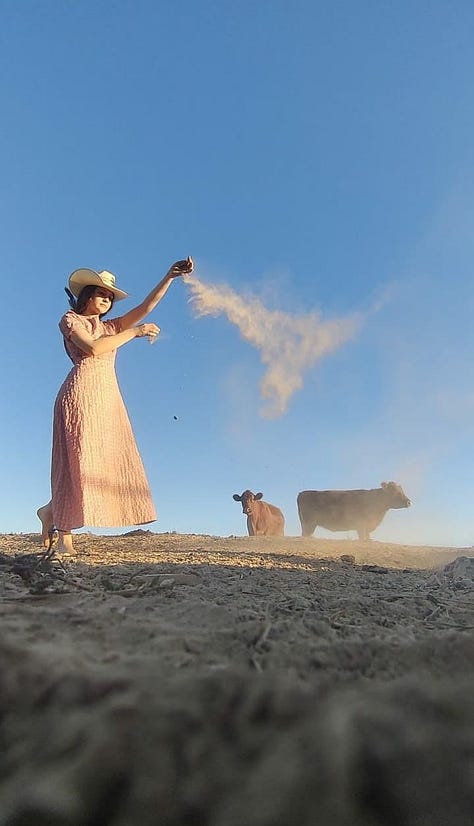




Construction
It’s not uncommon for women and girls to build in a thin cotton dress, however these women are rarely a novice in a dress. Picking up a hammer or climbing a roof is no big deal because they’ve been doing it since they were young.
If you’re just starting out, I recommend you wear something durable and of moderate fullness. Not so full that your skirt catches on anything, but wide enough to move in. Mid-calf length is usually good — long enough to be feminine, but not so long you trip while working. Culottes are also an option, although I never wear them. I find they offer little benefit.





Boating
If you’re canoeing or boating for recreation, the type of skirt or dress you’re wearing is inconsequential. Just make sure you don’t mind it getting wet! Usually I wear swim-wear when canoeing. However, If I don’t plan to swim I will wear a regular dress.
For all work-related activities on a boat, you’ll want to make sure your dress is made of appropriate materials for the weather, season, and work you’re doing. Do some research to figure out what other women are wearing when crabbing, lobstering, fishing, etc.
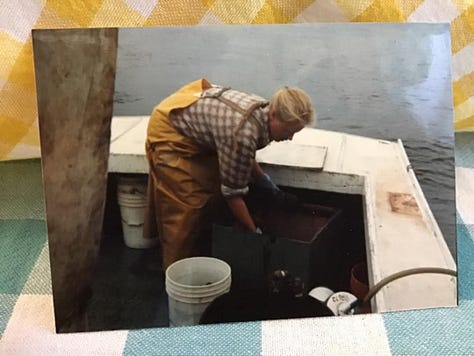
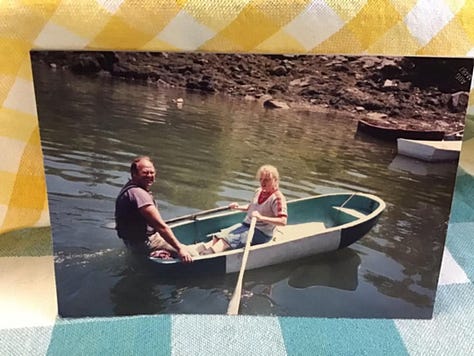

[These pictures were taken when] in 1987. I was nineteen, I worked the lobster boat to pay for Bible College. Funny that people think it can't be done in a skirt because men have used "oilskirts" over their clothes since before I can remember. - Linda Remillard
House work

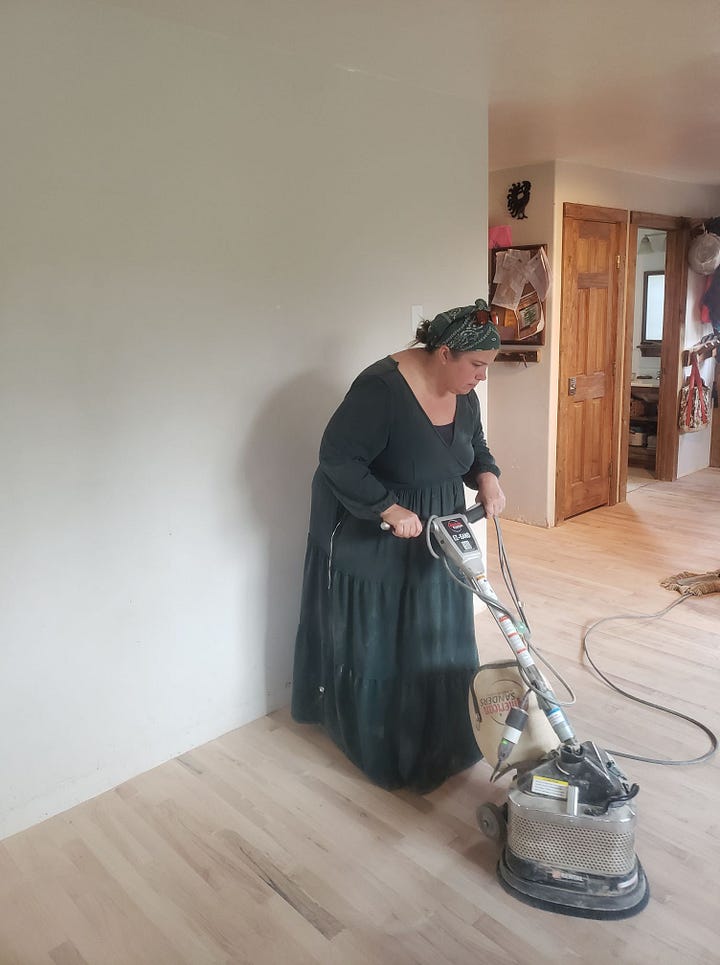
I’ll keep this section brief, because much of what I might say can be pulled from other sections. You’ll want to dress according to the seasons — more wool and layers in the winter, light weight, breezy dresses in the summer. Most house-hold tasks are easily done in whatever clothes you’re wearing. I’ve had a few people ask me how to mop in a dress. If your dress is getting in the way, you can tie it up or tuck it into your waistband. If you’re worried about chafing your knees when on the floor, wear leggings or have a mat to kneel on.
Gardening
Gardening is probably the most pleasant in a dress. You’re already doing a beautiful work when you plant and grow. Wearing a dress while in the garden makes it only all the more enjoyable. I prefer to wear an old cotton dress that I don’t mind sitting or kneeling in. The fullness and fiber content of the dress matter little, unless you’re working with thorns in which case you might want to wear a canvas or denim skirt with leggings (I usually only wear cotton leggings).
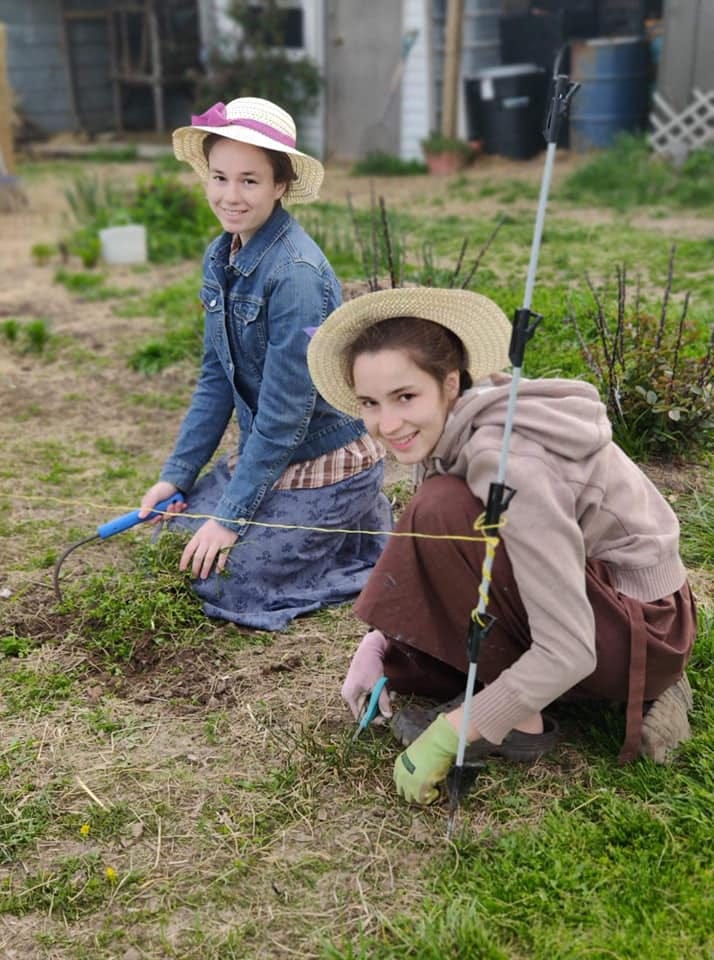

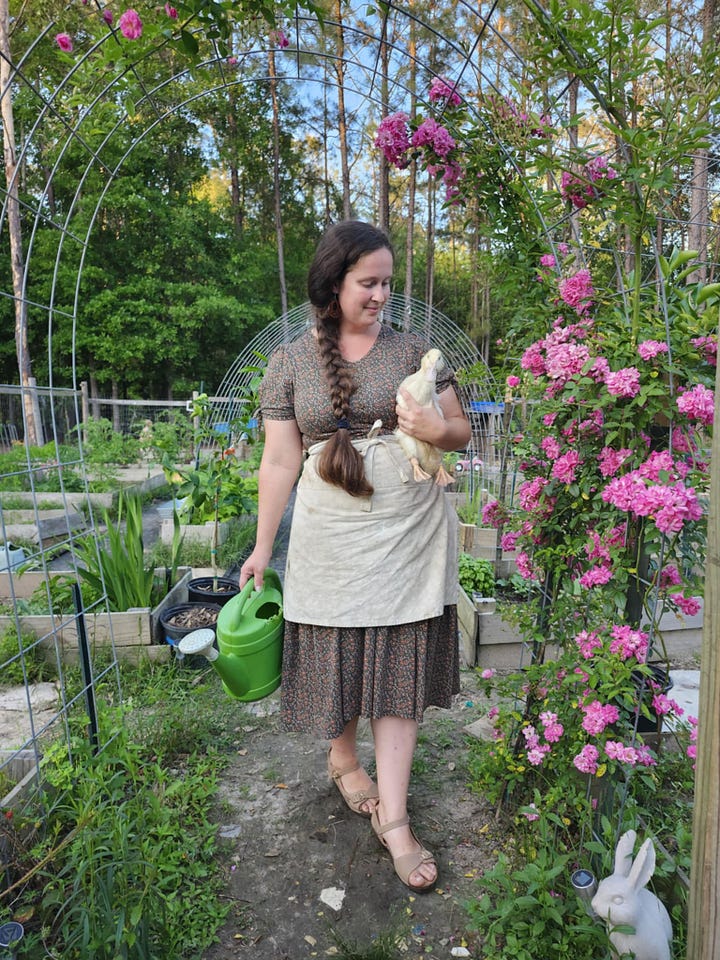

3) Children
Wearing a dress is an skill that can only be learned by wearing a dress. It’s never too late to start, but the best time to begin is as a child. The clothes your body learns coordination and motor skills in will impact your level of ease as an adult. Climbing a tree, riding a bike, weeding a garden, swimming. These are things I learned to do as a child in a dress.
This is why many Amish women will look at you in baffled manner when “How do you do x in a dress?”
They really don’t know. It’s intuitive for them.
When I was a child I’d catch my dress in the bike chain — now I don’t. Sometimes it truly is as simple as that.


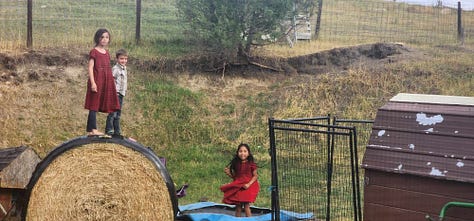
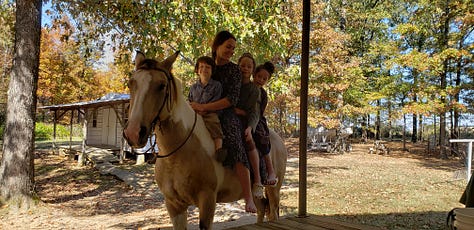


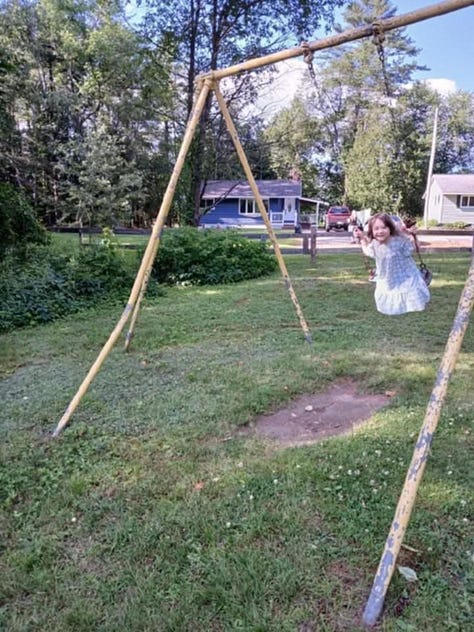

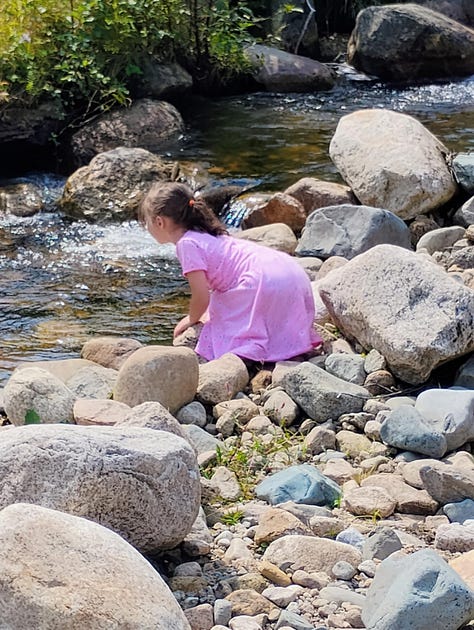
Put your babies in gowns or dresses
Until fairly recently it was uncommon for babies to be in anything other than gowns or dresses regardless of gender9. The Amish still do this. It is better for potty training, and incentivizes little boys to “earn their britches” . When they are little, long cotton or flannel gowns are sufficient. As they get older, and start crawling about, you may want to shorten their dresses to about knee length and put tights or leggings under their dress.
Let them climb trees and play rough
A dress should not disrupt your child’s play. Once they are walking, they should be able to manage wearing a dress to about mid-calf — longer for church. You can put them in knee length dresses, but there’s minimal added benefit once they start walking. Mid-calf is a great learning length. Our mother made us older girls frilly cotton bloomers to wear under our dresses that were knee length — a little shorter than our dresses. My little sisters often wore tights or leggings under their dresses.
You will have to instruct your girls on how to ride a bike and swim the first couple times they attempt it, but they’ll learn best through trial and error. It really only takes catching your skirt on a bike chain once or twice to realize how to not do that anymore.
Avoid skirts for small girls
Skirts are harder to manage than dresses. Until a girl has developed a waist and feminine grace, her skirts will more easily fall down, snag, or cause her any number of embarrassments and discomforts. Dresses and jumpers are better suited to small girls.
Let them earn their waistlines!
Choose styles that are loose, not too full, and made of breathable materials that are easy to mend such as cotton and linen. The best styles for small girls have are a-line with no waist, or are moderately gathered at the waist.
Avoid any synthetic materials
It may cause skin irritation and can be scratchy to soft baby skin. It is also more dangerous around fires and could cause permanent scarring or death.
Don’t offer her choices
I don't see any need to allow your daughter to choose what she wears when she is young. You buy/ make her clothes. As she gets older you can allow her to have more input in her styles and prints until she is making and buying her own clothes. If she is raised to have a good outlook on her own femininity, has supportive peers, and has been properly instructed on dress-wearing, she most likely will not want to ditch her dress.
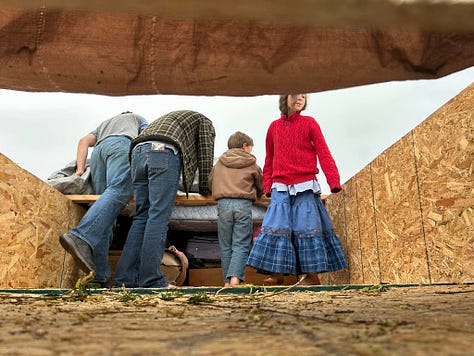

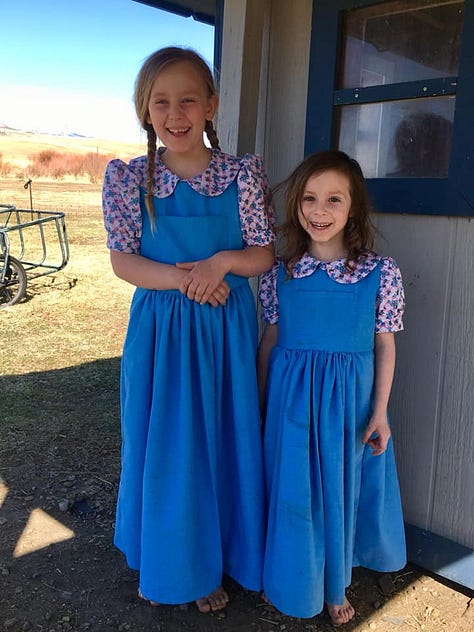
Bonus: For the Mother
If you’re the mother and new to wearing dresses and feel disheartened at how to play with your children in a modest, comfortable way, don’t be discouraged! A dress should not prevent you from being a good mother. If anything, you may find it boosts your spirit and energy.

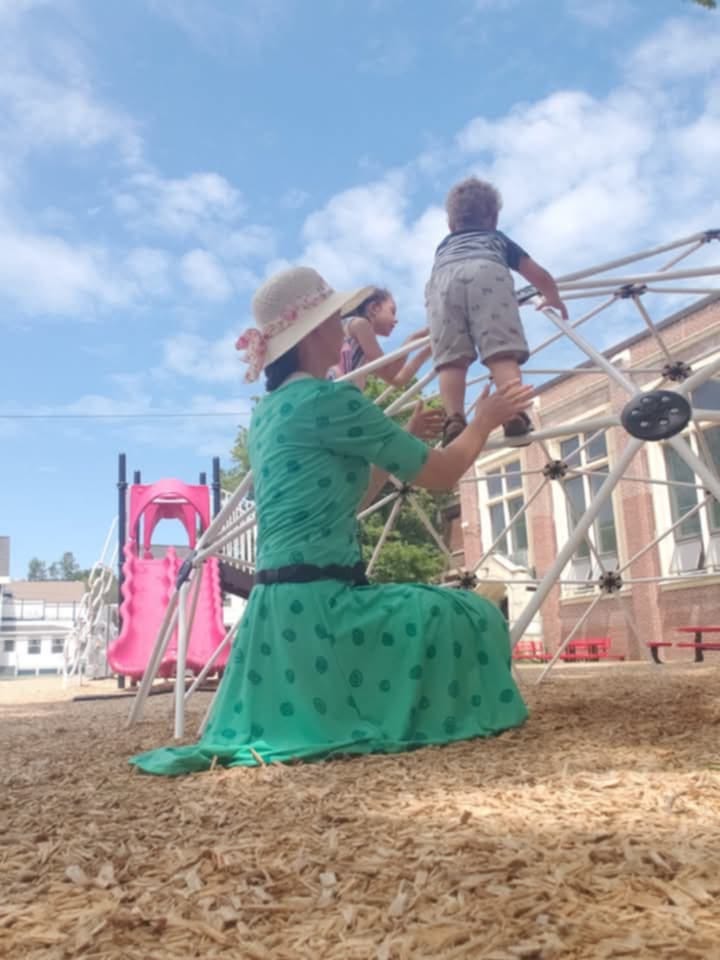
There’s nothing so cute as a small child holding onto his mother’s skirts! If you’re worried about your child pulling your skirt down, avoid skirts and wear dresses instead.
If you enjoy sitting on the floor to build blocks with your young child, and you’re not accustomed to minding your legs, just wear a pair of leggings or shorts or bloomers under your skirt. If you don’t want that extra layer, all you need to do is make sure your dress is full enough to spread out when you’re sitting on the floor. When you are ready to stand up, grab your skirt from between your knees, making sure to have both the front and the back, and scrunch it in your fist as you rise. This will prevent flashing.
4) In The Woods
Our grandma had taken us to a summer church-camp, and we were just sitting down to eat lunch when a man came up to speak to my grandma about something. I was probably eight or nine — old enough to see that Grandma was barely returning the conversation. As soon as the man was done speaking, she rushed to the bathroom. Later on she told me, “Right as he came up a bug crawled down my bra!”
I’ve never found myself in such a social situation, thankfully, but I have had ample experience with bugs crawling down my shirt — or up my skirt. My entire family likes to spend a lot of time outdoors. We encounter bugs, snakes, ticks, the elements, etc. These are things that can’t always be avoided, but there are ways to ensure a more comfortable experience while wearing a dress.
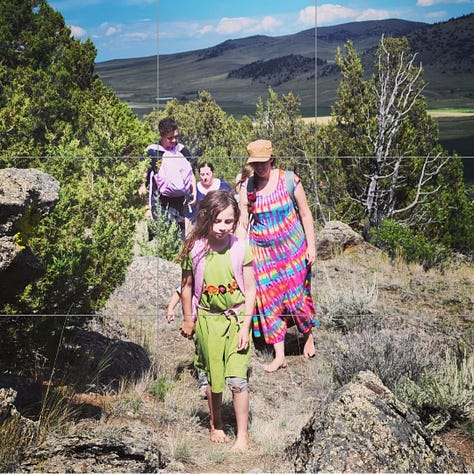

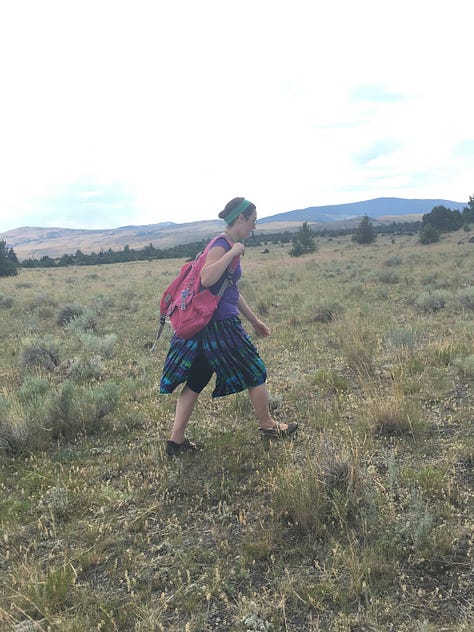



Hiking
I prefer to hike with leggings under my dress. I mostly avoid stretchy fabrics, but often wear a cotton jersey skirt or dress to hike in. Depending on the intensity of the hike, any dress that is moderately full and above the ankle is good for hiking.
Sometimes I’ll wear a thigh or knee-length skirt to hike in, but there’s rarely any advantage to doing so. As long as you aren’t stepping on your hem, a long dress in the woods is no issue. If the dress is too full it might snag on nearby branches, so I prefer to wear a dress of moderate width.
I usually use a home-made bug spray and have next to no issues with insects or ticks. I mostly wear leggings to prevent chaffing, but it also helps with bugs. Nevertheless, no matter what you’re wearing there could be an issue. There is no fool proof method for avoiding ticks. When you’re home, you’ll still need to check.
You could have fun with it though — my siblings and I used to compete when we were younger to see who could find the most ticks end of each day10. The was no significant difference in count between the brothers or sisters, though, so I doubt our clothing mattered that much.
Thorns
If I know I’ll be dealing with thorns, I’ll wear thicker clothes — leggings won’t be enough. A denim or canvas skirt should be. And then I bravely bulldoze through them.
When I come across thorns in a thin dress and I have no leggings on, I’ll gingerly trample them, pulling my dress tightly around myself to prevent tearing. It’s like crossing a barbed wire fence that has no shape. It helps if there is a boy or a man around, because they’re usually more than willing to take any scratches for your sake without being asked.

5) Recreation
As I have already tried to show, a dress need not doom you to an inactive lifestyle. You can do any manner of work safely in a dress. Dresses need not be impractical. And they shouldn’t prevent you from having fun, either.
If the dress poses an issue, you’re wearing the wrong dress or still need to be more practiced in moving around. Experiment. Get comfortable with your closet. Know which garments and which fabrics work best on you.
Bicycling
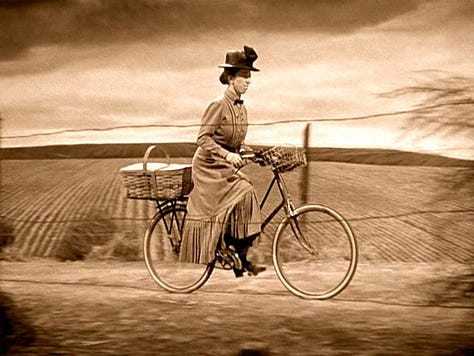
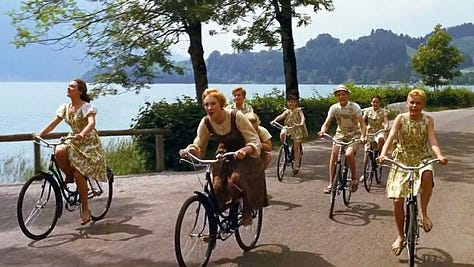

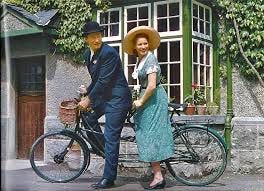
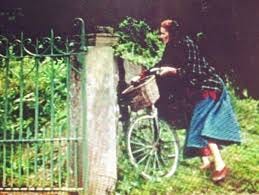
Have you noticed that the top bar on women’s bikes tends to slant downwards while it remains high and straight on a man’s bike? I’ve heard some claim this was done to accommodate women’s full skirts. That’s a myth as far as I can tell. The structure of a women’s bike was designed to favor her autonomy, not her clothes. The lower bar meant she wouldn’t need to raise her legs so high, but it didn’t help keep her dress out of the chain — a chain guard would.
Unless you have a chain guard (none of my bikes ever did), you’ll need to know a few things in order to safely ride your bike.
1) Your hem length doesn’t need to matter, but if you’re riding long distance it might be easier to wear a skirt that’s mid-calf. Knee length skirts are fine, too, but offer little extra benefit
2) Skirts that are too full are more difficult to manage than skirts that are too long — a long dress with a straight cut is usually pretty easy to ride in without much worry. You want to be able to have enough room for your knees, but not so much that excess fabric flies freely around you
3) If your dress is long or too full, bend over and grab the hem between your legs making certain to take from both the front and back of the skirt, pull the hem up under you, wrap it over your seat, and sit on it. This will create a sort of billowing harem pants look. Alternatively you can tuck part of your hem in at your waistline, over a bag you’re carrying, or secure it in a knot with a hair tie.
4) Before going far, look down to make sure none of your hem is dangling too near the chain



Swimming
When my husband first started courting me he came to stay with my family for two weeks. Halfway into his visit I sent him off with my siblings to go fishing. When he came back he told me how, although most of my brothers were in shorts and shirts, one of my brothers wasn’t dressed to swim.
“I figured he’d come along only to fish since he was wearing jeans and a button-up shirt. But then he jumped right into the lake.”
I’d never thought about how strange this was until he pointed it out — my siblings and I will wear proper, modest swimwear. But we also will go in our clothes if we don’t feel like changing into swimwear. For this reason alone I’ve swam many a time in a long dress.
That being said, swimming is the only thing I find difficult to do in a long dress. But then, I’m not the greatest at swimming. There are many other girls — many who are of Amish and Mennonite descendant — who swim well in long dresses and enjoy doing so.
I prefer to wear a dress that’s about knee length — the shortest I’ll wear for anything. I always wear leggings or shorts under my dress.
I prefer to swim in cotton jersey or sort of material that doesn’t get too heavy in water. I’ve made my own swim dresses out of cotton swim material. You can also buy fantastic swim dresses online, although any medium length sportswear dress will do fine. I’ve found dresses at Walmart that were made for summer wear/ hiking but worked fine in the river or pool.
When swimming in a dress, don’t overthink it. Dive in and swim . . . your dress will come around you and find its own rhythm. The wrong material might cause you to lag, but you won’t drown. When getting out of the water, I’ll grab the hem of my dress, bring it up so as to let air underneath, billow it around me, then pull it down so as to prevent clinging in odd places.
Horse riding

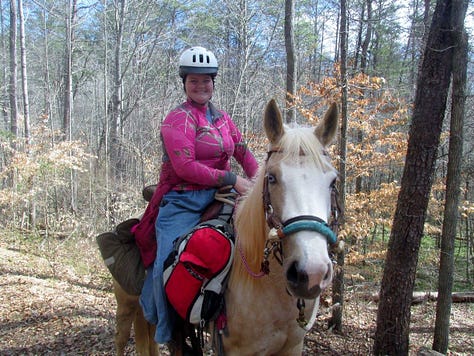
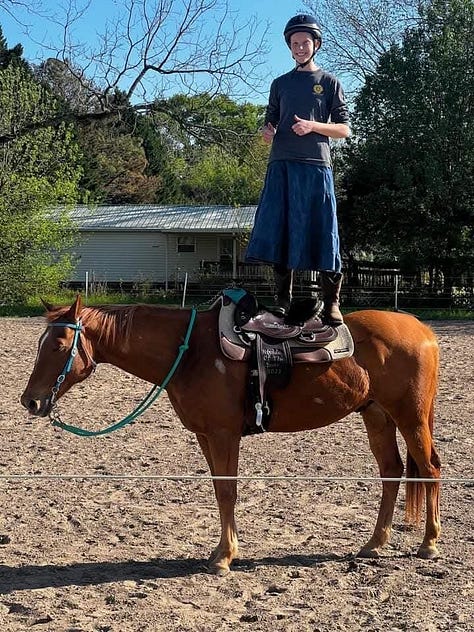

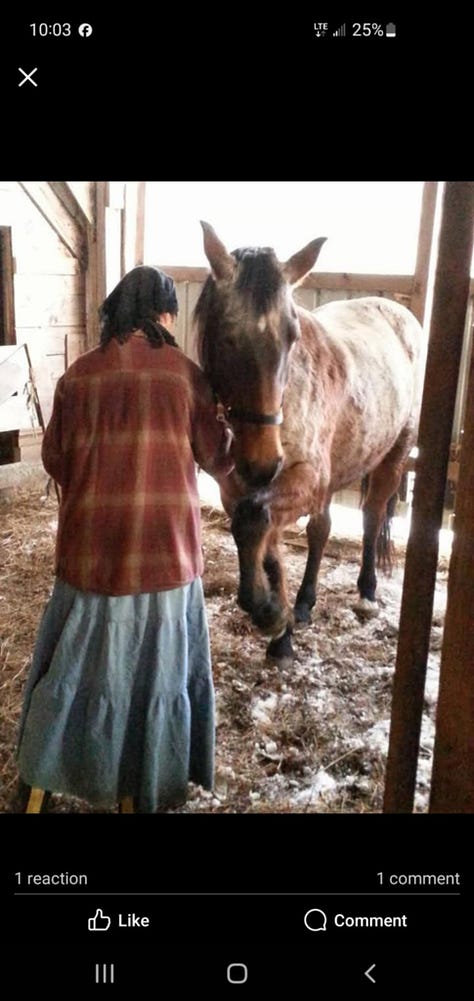
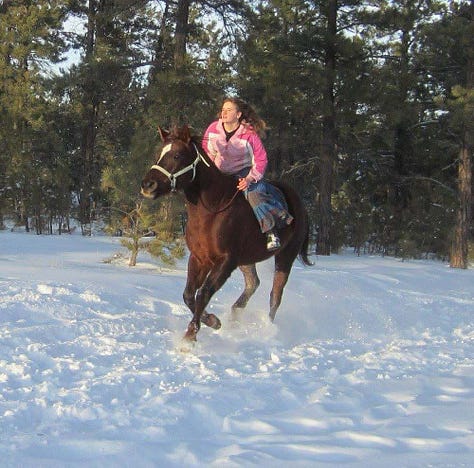
I started riding horses when I was around eleven. I had a flared denim skirt I preferred to ride in. There was a time where I’d ride for hours everyday — sometimes with leggings, sometime barelegged with no saddle.
I rode a variety of horses, some gentle, others spirited. I managed to remain on a rearing horse a few times! I was bucked off a few times. When I was a little older, we lived with the Amish for a time and we had a buggy. Once I was driving my little siblings to see a neighbor when our horse spooked, then turned frantic and uncontrollable. There was little I could do from inside the buggy except try to reign him in, which I managed to do long enough to get my siblings out until someone could help. A few years later I was riding another horse that spooked. I got the horse under control, but then dismounted and tied it to a tree. When I turned around, it kneed me in the back and knocked me out.
Although all of these incidents were terrifying, the dress I wore never once added to the risk. Horses are dangerous beasts, yes. But you’re more likely to get mangled from getting your foot caught in the stirrup than face any sort of deadly consequences due to your dress. If the fabric is thin enough and catches, it will tear. I’ve had that happen — you mend it, no big deal. If you’re wearing a durable dress, there’s less risk of it tearing.
There is simply no proof of pants being safer than dresses even in horse riding. Also I want to note that side-saddles, like lower bars on bikes, weren’t designed to accommodate dresses, but propriety. It was considered uncouth and indecent for a woman to spread her knees. You don’t need a different saddle to ride a horse in a dress, and you can wear a dress just fine in any saddle (or bareback).
When mounting a horse, you don’t need to worry about the dress at all. Simply swing your leg over, and the dress will follow along. You might have to lift yourself up a little to tuck your dress under yourself, unless you don’t mind it billowing our behind.
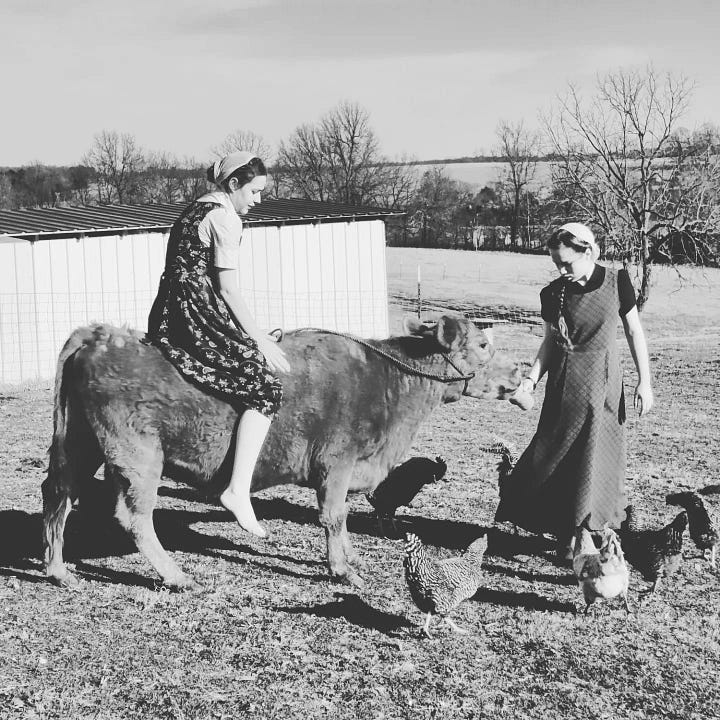
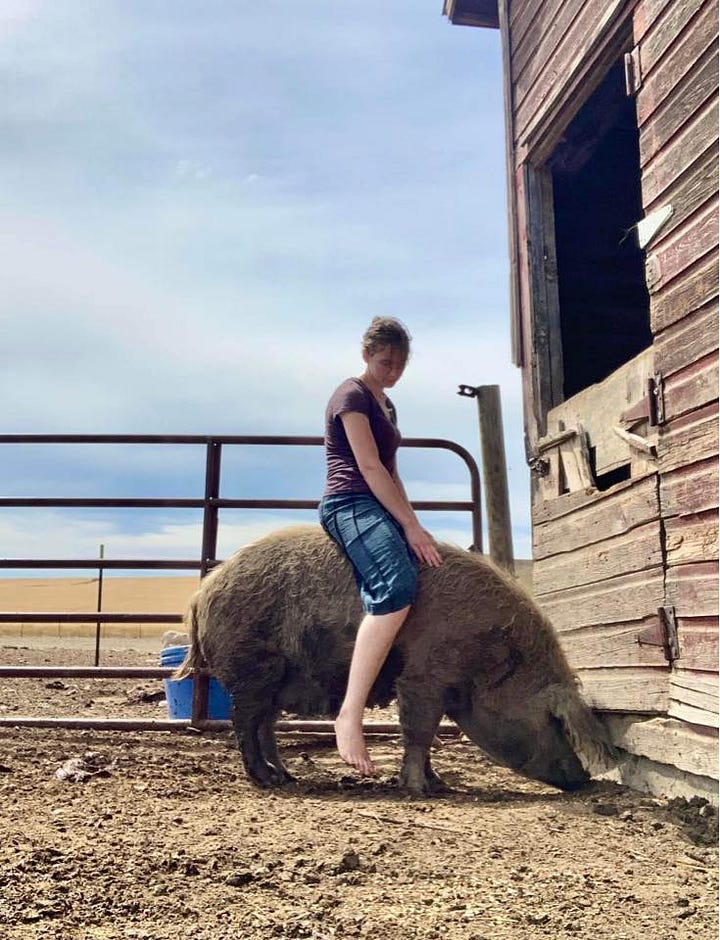
Rock climbing

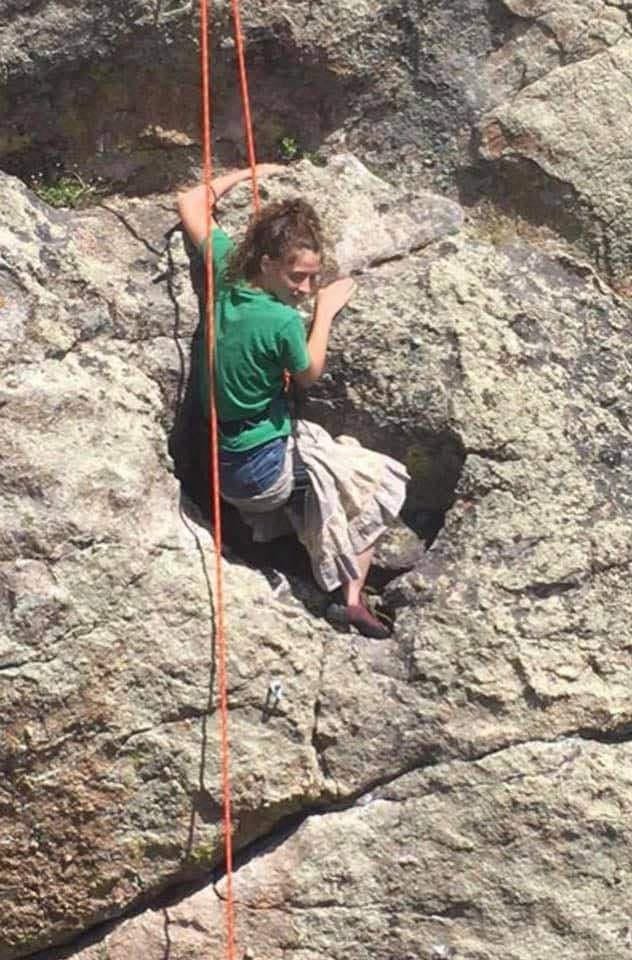
Several of my siblings love to skydiving and rock climbing.
Neither of these are activities I’ve been particularly interested in mastering, but many women are, and do them just fine in a dress. Rock climbing especially is dangerous no matter the clothes you wear. My sisters insist dresses don’t add to the risk. Once the harness is on, the dress is mostly tucked away anyways and you’re hardly even wearing it anymore.
At which many may ask, “What’s the point of wearing it then?”
The point remains the same: to retain femininity. One doesn’t need to wear the clothes of a man to work or to have fun. When rock climbing, little modesty is added by wearing a skirt, but a woman is set apart from the men by the simple act of keeping her skirt on. Practically speaking, nothing is gained but there’s no hindrance either. It’s symbolic more than anything.
My sisters usually wear canvas to climb rocks, though they’ve also been known to wear light-weight cottons. I’m sure they’ve occasionally ripped their skirts, but not as often as one might imagine. For the most part, the skirt seems to glide along with them.
Hunting
My sister, Jerushah, does much of the family hunting and butchering. She often wears a camouflage or black canvas skirt just above the ankle with leggings underneath. Sometimes she wears a pair of culottes she sewed. She has spent days in the woods tracking down deer then hauling them out. There’s something about the fact that she’s always wearing a dress when she emerges from the mountains with her bounty.



6) Fancy Dresses
There is no shame in occasionally ditching all practicality when dressing up.
This is when you wear the fabric that could easily snag or rip and light up in flames. The skirt that is too full and too long, and the bodice that is maybe a little too tight. You want extravagance, not just everyday femininity. But because you’ve already been wearing a dress to bale hay or brand cows or swim or bike, you’ll be the most elegant woman at that gala. You’ll look like you were born in Cinderella’’s dress, not stuffed into it by accident.
Whenever I dress up, I let the dress do the work for me. I don’t shave, even for the sleeveless gowns. I don’t do makeup. I style my hair elegantly, but I don’t overdo it. I wear minimal jewelry and perfume11. It’s a toss up over whether or not I’ll wear heels or arrive barefoot.
Here are some extra tips to manage that big dress:
1) When using the toilet, pull your dress up only in the front, turn around, and straddle the toilet from the opposite direction so you’re facing the wall instead of the door. The rest of your dress will fall behind you to the floor and won’t get into the toilet
2) When returning your dress to the closet, hang it wrong side out. This prevents lace, embroidery, or beading from snagging and glitter from spreading
3) If you’re wearing something that’s historically correct, or dealing with a lot of petticoats, read some books on etiquette for events, or try a YouTube video tailored to your particular dress

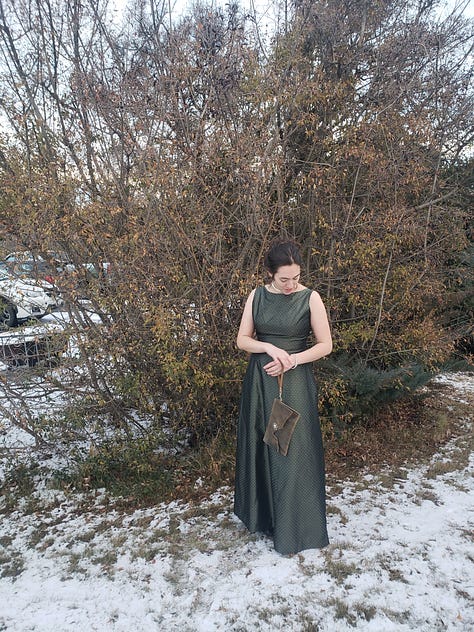
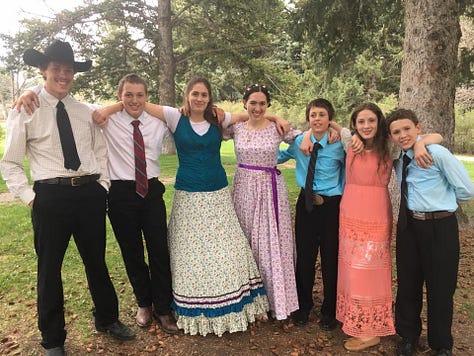
Embrace Feeling Vulnerable and Exposed
As exhaustive as I intended to be, there’s much I didn’t cover. I wrote nothing on surfing — I’m leaving that one up to you! I hope that what I did share here is enough to get you started. I tried to focus on the main nuts and bolts while including a few pretty nuggets.
Only you know the chores and hobbies that make up your everyday life. But maybe this will help you know just what dresses and skirts to make and purchase. Filling your closet with the correct assortment might be slow going at first. It will take a lot of consideration, thoughtfulness, and experimentation with styles and fabrics to find just what works for you. This could take years. But the results will be rewarding for both you and those around you.
It is worth it! You will have more variety. The simple act of choosing a dress over a pair of sweat pants or jeans will awaken parts of your feminine self you didn’t know existed. If you’re not used to dresses, you may initially appear unnatural and awkward. This is perhaps the thing that might deter you the most at first.
At first you might feel exposed. Those feelings of exposure is your femininity taking in a sudden rush of air — it can breathe! It is a delicate thing to be beautiful, and it will take some adjustment before you feel like this is a good thing. You will feel vulnerable, and maybe even immodest. You will stand out in a way that you’re not sure is completely good. You will look like a woman among sexless beings. And you might feel ashamed at first.
But in time, you’ll grow less self-conscious and more at ease with your womanhood. You will become more capable, intuitive, and graceful. And you’ll find that the self you thought was you was but a seed waiting to bloom.
It is a good thing to expose your femininity, as long as you do so with grace and dignity.
Not only will your unlocked beauty be an inspiration to those around you, and lead the others to a better understanding of God, it will get you places, too. The world trusts women the most, and the more feminine you appear the more opportunities will unfold before you . . .

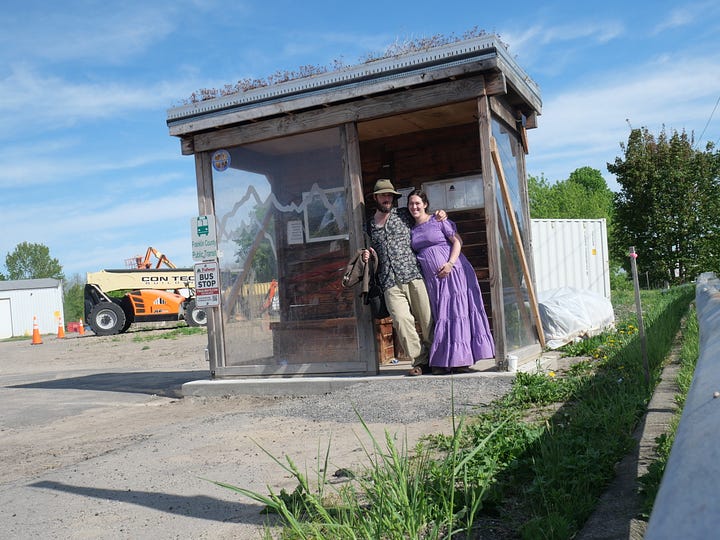
Polite Company is free to readers. However, if you would like to support my writing, feel free to buy me a coffee:
If this doesn’t apply to you, no worries — this is a guide written for women who want to wear dresses more often. I am not attempting to convince anyone of anything they are not already interested in at the moment. Not in this essay at least.
The only thing that I can think of that would fit in this category would be combat fighting/ war. And maybe even that can be done in a dress … after all, men had no option for thousands of years and still managed to win many a battle.
There is much controversy concerning how Rayon is made and whether it is even a natural fiber by the time it’s processed. I love it’s drape and how it has a sort of dance to its weave, and it doesn’t make me have bad body odor. That’s enough for me.
Also shorts are just really, really ugly. I don’t know why nobody has ever told women this — but shorts are not attractive, unless they’re booty shorts, and those are attractive for all the wrong reasons. But I don’t want to turn this into a modesty post, so I digress.
Preferably never wear polyester, but especially in the summer time.
Unrelated to dresses, but I used to have a persistent underarm hair bacteria. No amount of soap or bathing would rid it. Even shaving only temporary worked. I nearly gave up on it (after like two years) when I thought to use a colloidal silver topical gel I had in my bathroom cabinet. I applied it twice — a week later it was gone.
Because I am less concerned with modesty than femininity, I rarely wear leggings unless I’m cold, and I wear slips only with silk or fancy dresses.
I have quite a few friends who claim to brand in a skirt, but have no pictures of themselves doing it. They are mostly of Mennonite descendant, although some are from rural christian families.
I’ve heard it said that sleepers are more popular for babies now because of how common it is to strap babies into things: car-seats, highchairs, swings, strollers, etc. If you can’t get around using any of those things, you can still have your baby in a dress with leggings or tights underneath.
We didn’t believe in Lymes lol
Often I’ll use essential oil instead





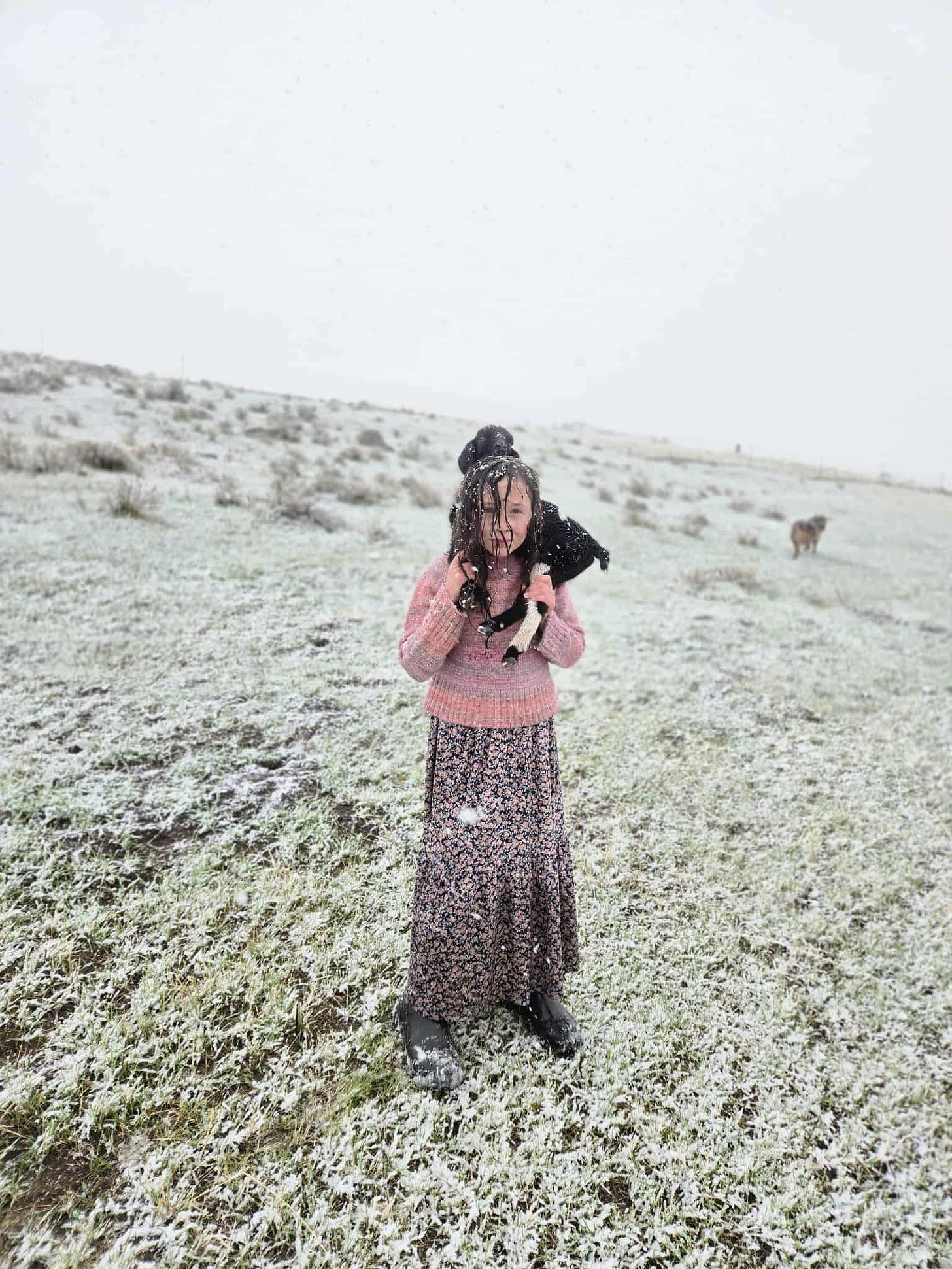




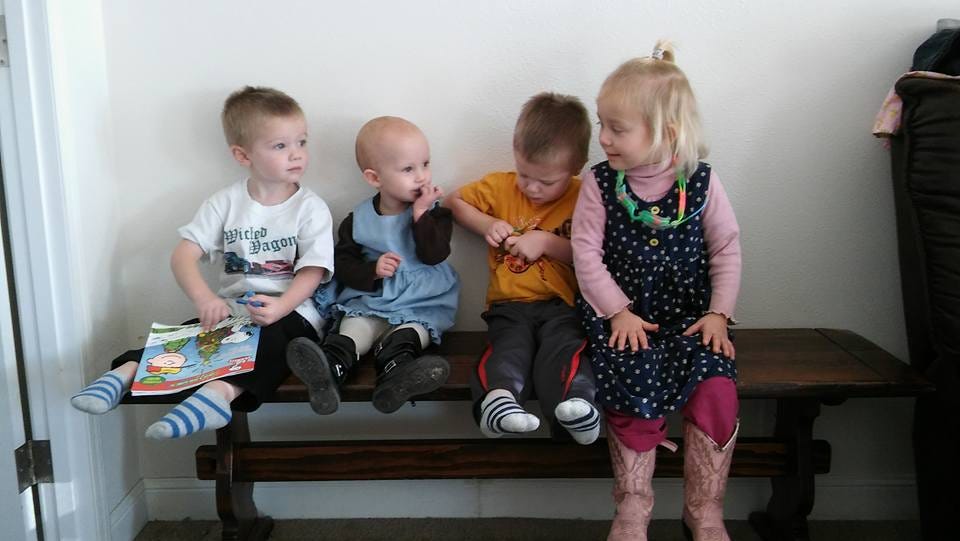
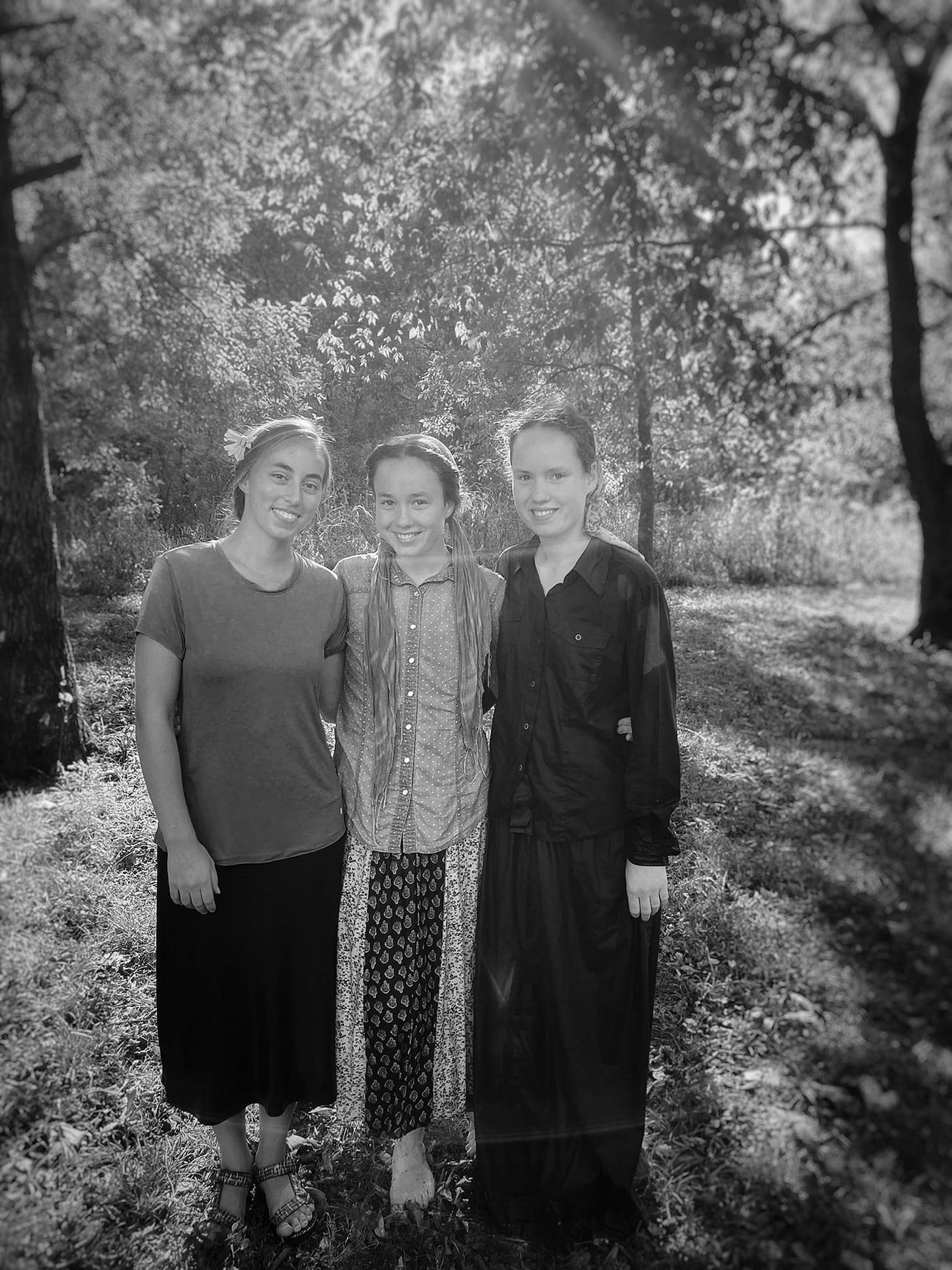
What a powerful conclusion to this master guide for wearing dresses. I never quite pinpointed the feeling I get after wearing exclusively dresses for a few days as "vulnerability," but that is spot-on. "You will look like a woman among sexless beings."
At this point I am finally quite content in my identity of being an old-fashioned, feminine, religious woman. But maybe I am still growing into my identity as a 𝘣𝘦𝘢𝘶𝘵𝘪𝘧𝘶𝘭 woman. Thank you, Keturah, for this wonderful article.
Thank you for this article, Keturah. I grew up wearing dresses and still do, and many of the things you wrote about are instinctual for me. I love wearing dresses and I feel much more respect from the general public in a dress than out of one. It also works backwards, the respect thing. I have more respect for people when I am respectful of my femininity.